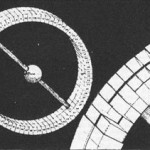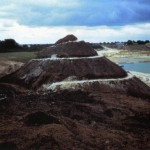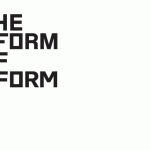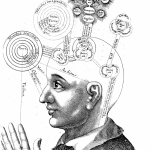
The Observatory is a land-art piece by Robert Morris located in Flevoland, in the Netherlands. The first version of the project was created by the artist in 1971 for the open air exhibition “Sonsbeek buiten de perken” (“Sonsbeek out of bounds”) and built in the dunes near Velsen. A year later, the artwork was dismantled and then it was rebuilt in 1977 in Flevoland.
The Observatory (here on google maps) consists of two concentric earth mounds (the exterior measuring a diameter of 71 m) crossed by three V-span openings and divided by a ditch. The interior circle is made by a wood structure which supports earth covered in grass and includes four openings, one of them being the entry. Coming through a triangle-shaped tunnel it is possible to get through the exterior circle right through the middle of the land-art work through the East-West axe. The other three openings in the central circle are oriented in order to frame the sunrise in some specific times of the year. The middle steel visor shows the sunrise at the equinoxes. On the northest and southest sides of the circles are two stone wedges, through which the sunrise on the 21 June and on the 21 December are visible.

Morris wanted his observatory to be easily accessible: of his first version of the Observatory, 1971, he says: “I was pleased with the site because people could get to it, and insofar as I do something like that, that is physical I want it to be experienced for what it is. It is important to me that it is there and available”
Since 1965, Morris began his studies on the astronomic observatories of the Neolitic age and this is his first built work which allowed him to materialize these researches. The explicit references to Neolitic sources, expecially Stonehenge, converge in this centric structure, which isolated the spectator while projecting him in the faraway landscape and even the celestial sphere, in close relationship with the cicle of the year and with his ancient history.

Rosalind Krauss relates the Observatory to Stonehenge:
Morris had begun to think about the structures both made (like Stonehenge) and found (like caves) by prehistoric societies to convert the arc of the sun’s revolutions into the straight line of the intelligible, arrowlike trajectory, and thus to ‘read’ the solstices. Observatory (1971) is a massive project through which to think and to experience this culturally ancient notion of marking, which is to say, of entering into a text that one has not oneself written, and that will continue to be produced to the end of solar time.
(Rosalind Krauss, “The Mind/Body Problem: Robert Morris in Series, ” Robert Morris. The Mind/Body Problem, Robert Morris (New York: Solomon R. Guggenheim Museum. January-Aprii 1994))
For more informations on the relationships between Prehistoric observatories and land art works, comprising Morris’ Observatory, read “Land art: layers of memory – The use of prehistoric references in land art“, a thesis by Iris Amizlev at the University of Montreal (1999). “A Neolithic work such as Stonehenge, with its orientation to the solstices, provides a precedent for Morris’s Observatory, Holt’s Sun Tunnels, and Charles Ross’s Star Axis.” (Beardsley: Probing the Earth)













Further readings:
I labirinti di pietra tra architettura e paesaggio (In Italian)
Robert Morris: Land-Reclamation und Erdmonumente by Thomas Dreher (In German)
Rosalind Krauss: Sculpture in the Expanded Field (already on Socks, here.)
Images via:





Nice post; thank you. I used to live nearby. The observatory itself is still intact. But the site and surroundings have been distroyed by the construction of a railwaytrack and a highway right next to it. Due to this infrastructural overkill the site has become somewhat obscured and difficult to find.
Every year, after the shortest night (20/21 june), there is a poetyfestival around sunset inside the observatory.
http://www.festivalsunsation.nl/